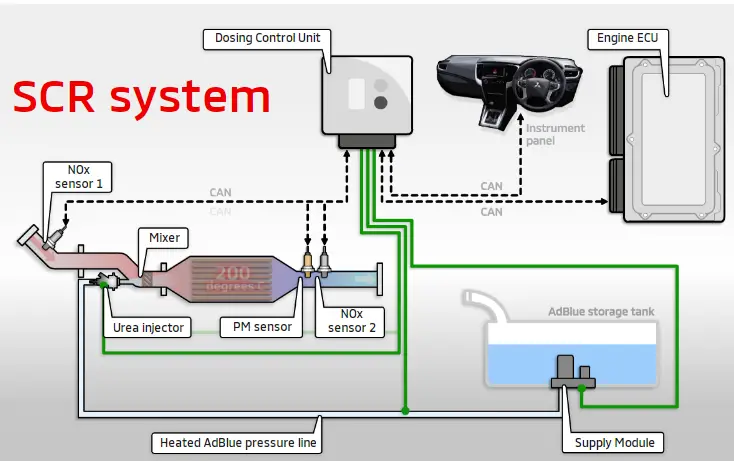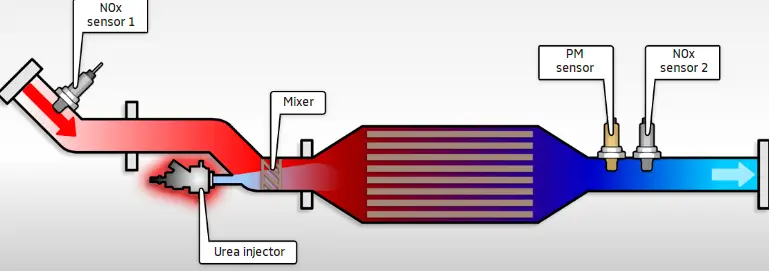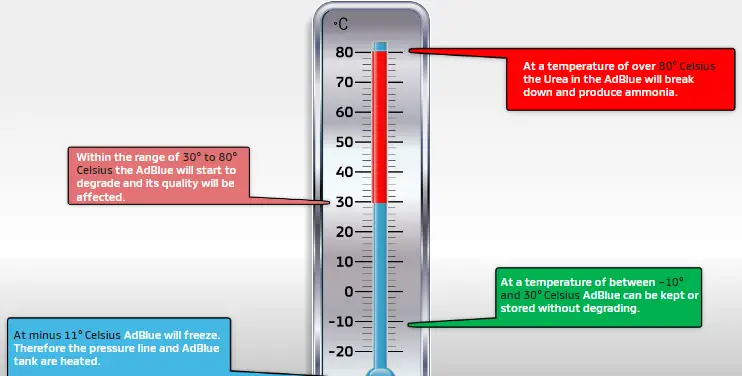Why do we need that?
Exhaust gases are produced by all combustion engines. Others, such as Particulate Matter and Nitrogen Oxides, contain compounds that are harmful to human health and the environment. Nitrogen Oxides, or NOx emissions, are of particular concern for diesel engines since they can contribute to breathing and lung difficulties in sensitive persons. They also accumulate in the atmosphere, causing pollution and acid rain, so it’s no surprise that governments all over the world want them gone. The implementation of Euro 6 emissions requirements in 2015 required a large reduction in NOX. Previously, we used a NOX trap Catalyst on some of our vehicles to decrease NOX. This method absorbs NOx using a specific barium catalyst, which is subsequently broken down into innocuous gases by a chemical reaction activated by introducing diesel fuel into the exhaust. However, new automobile models will be certified against the Euro 6d emission regulations using even more demanding and realistic tests in 2018.
Selective Catalytic Reduction.
Some manufacturers may slightly different system use.
The SCR system employs a urea-based liquid reduction agent known as AdBlue, which is stored in a separate tank and injected into the exhaust to achieve a reduction in NOx emissions of up to 90%. A number of additional components have been added in their place. The SCR system is more complicated than the NOx Trap catalyst. To learn more about the remaining components, click on them. After we’ve gone over the components, let’s have a look at how the SCR system works. It’s a ‘closed-loop system,’ which means it’s self-adjusting.

The first NOx sensor measures the NOx level in the exhaust stream as it exits the engine. When NOx is detected, the Dosing Control Unit determines how much AdBlue is needed, which is subsequently injected into the SCR catalyst via the urea injector. Within the catalyst, AdBlue degrades into Ammonia, which combines with the NOx, reducing it to harmless Nitrogen and Water. The second NOx sensor monitors the NOx level when the exhaust gases exit the SCR catalyst. This measurement is given back to the Dosing Control Unit, which can then alter the amount of AdBlue injected if necessary. This loop is endlessly repeated. Between the two sensors, up to 90% of NOx in the exhaust can be reduced. However, before it can operate, the SCR catalyst must first warm up to around 200 degrees Celsius. The chemical reaction can only take place at this temperature.
More information about the catalyst system is here: Mitsubishi L200 MK6 Adblue, catalyst information and warning light.

Adblue information.
Let us now look more closely into AdBlue and the chemical reaction that occurs within the SCR catalyst. AdBlue, often known as Diesel Exhaust Fluid (DEF), is a colourless, non-toxic, biodegradable liquid-reducing agent.
It is not explosive, flammable, or environmentally hazardous. AdBlue is classed as a transportable fluid with low risk. Prolonged contact with liquid may cause mild discomfort and irritation.
It contains 32.5% urea and 67.5% deionized water.
It contains 32.5% urea and 67.5% deionized water.

Click on each section of the thermometer to learn how AdBlue reacts at different temperatures.
AdBlue will freeze at -11° Celsius. As a result, the pressure line and AdBlue tank are warmed.
AdBlue can be preserved or stored at temperatures ranging from -10° to 30° Celsius without degrading.

Within the temperature range of 30° to 80° Celsius, AdBlue begins to degrade and its quality suffers.
At temperatures above 80° Celsius, the urea in AdBlue will degrade and produce ammonia.
AdBlue has a standard shelf life of 12 months when stored at temperatures up to 30° Celsius.
Avoid exposing AdBlue to direct sunlight.
If you spill AdBlue on metal or clothing, simply clean it with water.
AdBlue may be obtained at most gas stations and will occasionally need to be refreshed.
The car has a dedicated AdBlue tank with a refill cap. Keep in mind that the AdBlue is kept in a separate tank and NOT mixed with the diesel fuel.

0 Comments